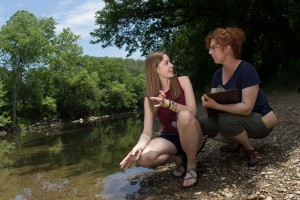
Testing the Waters
A Summer Science Scholar is studying whether microplastics are collecting in the river that flows around the Hill.
Jennifer Seely ’16 sits by the Kokosing River near campus sometimes to reflect. Watching the water flow, she wonders whether tiny fibers from polyester clothing are collecting in the river.
She found those fibers in the Atlantic Ocean on a semester she spent on a research ship, sailing from Barcelona, Spain, to the Canary Islands off western Africa.
Through Kenyon’s Summer Science Scholars program, Seely feeds her curiosity by taking water samples from various points along the river to examine for plastics, which also could include microbeads from soap or broken-down bits of larger items.
Research shows that plastics can release chemicals and are ingested by small river organisms, accumulating as animals are eaten up the food chain, Seely said. The polyester fibers are so small they slip through filters at water treatment plants and end up in waterways.
Seely, an anthropology major with a concentration in environmental studies from Mercer Island, Washington, also has asked nearby residents to take a survey on their opinions about the river and their habits of visiting, which she’ll consider alongside results of her river testing.
She is one of four dozen students who received a $3,500 stipend for summer research, often working one-on-one with faculty members.
Seely is getting help on her research from Professor of Biology Siobhan Fennessy, the Philip and Sheila Jordan Professor in Environmental Studies, who studies freshwater ecosystems.
Seely is aware that the Kokosing River is labeled as one of the most diverse and healthy rivers in the state by the Ohio Department of Natural Resources. “The Kokosing is a really clean river, and I might not find anything,” she said. But she points out that there has not been as much research on plastics in rivers as on oceans.
Kimmarie Murphy, associate professor of anthropology and the advisor on the project, said Seely is using anthropology’s strength of studying human behavior holistically, combining the natural science of testing the river with the social science of gauging how people use it.
“Jennifer is a perfect example of what a liberally educated person can do,” she said. “It’s that kind of thinking that you cannot teach if you go in with a silo mentality, and even if you go in with a discipline-specific mentality.”